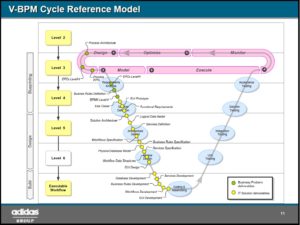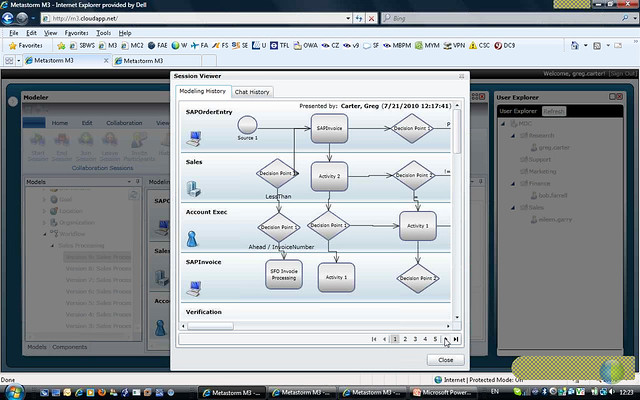I only have one day to attend CASCON this year due to a busy schedule this week, so I am up in Markham (near the IBM Toronto software lab) to attend the NSERC Business Intelligence Network workshop this morning. CASCON is the conference run by IBM’s Centers for Advanced Studies throughout the world, including the Toronto lab (where CAS originated), as a place for IBM researchers, university researchers and industry to come together to discuss many different areas of technology. Sometimes, this includes BPM-related research, but this year the schedule is a bit light on that; however, the BI workshop promises to provide some good insights into the state of analytics research.
Eric Yu from University of Toronto started the workshop, discussing how BI can enable organizations to become more adaptive. Interestingly, after all the talk about enterprise architecture and business architecture at last week’s Building Business Capability conference, that is the focus of Yu’s presentation, namely, that BI can help enterprises to better adapt and align business architecture and IT architecture. He presented a concept for an adaptive enterprise architecture that is owned by business people, not IT, and geared at achieving measurable business success. He discussed modeling variability at different architectural layers, and the traceability between them, and how making BI an integral part of an organization – not just the IT infrastructure – can support EA adaptability. He finished by talking about maturity models, and how a closed loop deployment of BI technologies can help meet adaptive enterprise requirements. Core to this is the explicit representation of change processes and their relationship to operational processes, as well as linking strategic drivers to specific goals and metrics.
Frank Tompa from University of Waterloo followed with a discussion of mapping policies (from a business model, typically represented as high-level business rules) to constraints (in a data model) so that these can be enforced within applications. My mind immediately went to why you would be mapping these to a database model rather than a rules management system; his view seems to be that a DBMS is what monitors at a transactional level and ensures compliance with the business model (rules). His question: “how do make the task of database programming easier?” My question: “why aren’t you doing this with a BRMS instead of a DBMS?” Accepting his premise that this should be done by a database programmer, the approach is to start with object definitions, where an object is a row (tuple) defined by a view over a fixed database schema, and represents all of the data required for policy making. Secondly, consider the states that an object can assume by considering that an object x is in state S if its attributes satisfy S(x). An object can be in multiple states at once; the states seem to be more like functions than states, but whatever. Thirdly, the business model has to be converted to an enforcement model through a sort of process model that also includes database states; really more of a state diagram that maps business “states” to database states, with constraints on states and state transitions denoted explicitly. I can see some value in the state transition constraint models in terms of representing some forms of business rules and their temporal relationships, but his representation of a business process as a constraint diagram is not something that a business analyst is ever going to read, much less create. However, the role of the business person seems to be restricted to “policy designer” listing “states of interest”, and the goal of this research is to “form a bridge between the policy manager and the database”. Their future work includes extracting workflows from database transaction logs, which is, of course, something that is well underway in the BPM data mining community. I asked (explicitly to the presenter, not just snarkily here in my blog post) about the role of rules engines: he said that one of the problems was in vocabulary definition, which is often not done in organizations at the policy and rules level; by the time things get to the database, the vocabulary is sufficiently constrained that you can ensure that you’re getting what you need. He did say that if things could be defined in a rules engine using a standardized vocabulary, then some of the rules/constraints could be applied before things reached the database; there does seem to be room for both methods as long as the business rules vocabulary (which does exist) is not well-entrenched.
Jennifer Horkoff from University of Toronto was up next discussing strategic models for BI. Her research is about moving BI from a technology practice to a decision-making process that starts with strategic concerns, generates BI queries, interprets the results relative to the business goals and decide on necessary actions. She started with the OMG Business Motivation Model (BMM) for building governance models, and extended that to a Business Intelligence Model (BIM), or business schema. The key primitives include goals, situations (can model SWOT), indicators (quantitative measures), influences (relationships) and more. This model can be used at the high-level strategic level, or at a more tactical level that links more directly to activities. There is also the idea of a strategy, which is a collection of processes and quality constraints that fulfill a root-level goal. Reasoning that can be done with BIMs, such as whether a specific strategy can fulfill a specific goal, and influence diagrams with probabilities on each link used to help determine decisions. They are using BIM concepts to model a case study with Rouge Valley Health System to improve patient flow and reduce wait times; results from this will be seen in future research.
Each of these presentations could have filled a much bigger time slot, and I could only capture a flavor of their discussions. If you’re interested in more detail, you can contact the authors directly (links to each above) to get the underlying research papers; I’ve always found researchers to be thrilled that anyone outside the academic community is interested in what they’re doing, and are happy to share.
We’re just at the md-morning break, but this is getting long so I’ll post this and continue in a second post. Lots of interesting content, I’m looking forward to the second half.



